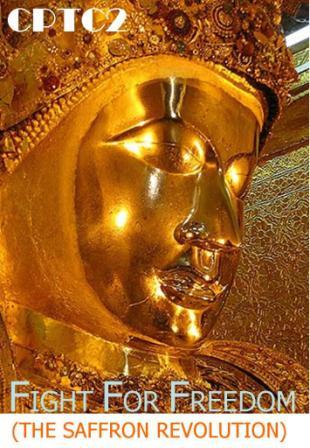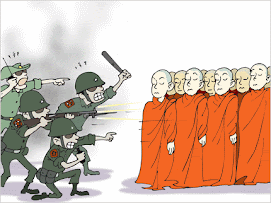Where Have All the Monks Gone?
By Shah Paung October 16, 2007
Until a few weeks ago, Burma had a very visible community of about 400,000 monks. Now they are a comparatively rare sight in the streets of Rangoon, Mandalay and other cities. Residents are asking: where have all the monks gone?
Burmese monks receiving for alms near Pegu, north of Rangoon [Photo: AFP]
Unknown numbers were rounded up in the recent demonstrations that rocked Rangoon and elsewhere. Many are still in detention, and others are confined to their monasteries. The authorities say they have released several hundred. But large numbers are very evidently still missing.
A resident of Mandalay, the historic heart of Burmese Buddhism, said: “Mandalay is now a city without monks.”
At the height of the demonstrations, the authorities banned the monks of Mandalay’s monasteries from continuing with their daily alms rounds, and a resident told The Irrawaddy on Tuesday that the groups of monks who had resumed their early morning tours of the city had shrunk from more than 50 to fewer than 10.
“When we asked the monks where the others were they didn’t dare answer,” she said. “We don’t know whether they still alive or not.”
A Rangoon monk contacted by The Irrawaddy was also reluctant to talk about the missing clergy. “We can not say anything about the situation, nor anything about the monks of Maggin monastery.”
Maggin monastery is in Rangoon’s Thingangyun Township, where the abbot, three monks and four other people were arrested on September 26. Two monks and two of the other arrested people have since been released.
An abbot at a monastery in Sittwe said that before the crackdown the number of monks in his monastery had shrunk from more than 260 to 20. Other Sittwe monasteries had lost about one third of their monks, he said.
On October 1, the Burmese authorities also arrested an Arakanese monk, U Kawwidda, abbot of Thatka Thila Zaya Thidi Pati Pahtan monastery in Rangoon’s North Okkalapa Township. He is a former president of the Rakhine [Arakan] Young Monks Union.
Some monks returned to their homes during and after the crackdown on demonstrations, and others fled to the Burmese-Thai border. Four monks crossed into Thailand in recent weeks, but two have since returned to Burma.
Until a few weeks ago, Burma had a very visible community of about 400,000 monks. Now they are a comparatively rare sight in the streets of Rangoon, Mandalay and other cities. Residents are asking: where have all the monks gone?
Burmese monks receiving for alms near Pegu, north of Rangoon [Photo: AFP]
Unknown numbers were rounded up in the recent demonstrations that rocked Rangoon and elsewhere. Many are still in detention, and others are confined to their monasteries. The authorities say they have released several hundred. But large numbers are very evidently still missing.
A resident of Mandalay, the historic heart of Burmese Buddhism, said: “Mandalay is now a city without monks.”
At the height of the demonstrations, the authorities banned the monks of Mandalay’s monasteries from continuing with their daily alms rounds, and a resident told The Irrawaddy on Tuesday that the groups of monks who had resumed their early morning tours of the city had shrunk from more than 50 to fewer than 10.
“When we asked the monks where the others were they didn’t dare answer,” she said. “We don’t know whether they still alive or not.”
A Rangoon monk contacted by The Irrawaddy was also reluctant to talk about the missing clergy. “We can not say anything about the situation, nor anything about the monks of Maggin monastery.”
Maggin monastery is in Rangoon’s Thingangyun Township, where the abbot, three monks and four other people were arrested on September 26. Two monks and two of the other arrested people have since been released.
An abbot at a monastery in Sittwe said that before the crackdown the number of monks in his monastery had shrunk from more than 260 to 20. Other Sittwe monasteries had lost about one third of their monks, he said.
On October 1, the Burmese authorities also arrested an Arakanese monk, U Kawwidda, abbot of Thatka Thila Zaya Thidi Pati Pahtan monastery in Rangoon’s North Okkalapa Township. He is a former president of the Rakhine [Arakan] Young Monks Union.
Some monks returned to their homes during and after the crackdown on demonstrations, and others fled to the Burmese-Thai border. Four monks crossed into Thailand in recent weeks, but two have since returned to Burma.
Time to Stop Coddling the Burmese Generals
By Htet Aung October 16, 2007
The political game in Burma is at its apex and members of the international community who are concerned about the nation’s future are trying to shed light on how things should go from here.
The Institute of Security and International Studies (ISIS) under the Faculty of Political Science at Chulalongkorn University in Bangkok held a public forum on Monday on “Burma’s Crisis: Ways Forward” with scholars, politicians, journalists, diplomats, and Burmese students attending.
Among the speakers at the forum were Larry Jagan, a former veteran editor with BBC World Service and currently a freelance journalist covering Burma, and Aung Zaw, the founder and editor of the The Irrawaddy magazine, who, as a student, took part in the 1988 popular uprising.
“We have to keep the issue alive, and we have to keep the momentum going,” said Aung Zaw, who knows firsthand the smell of tear gas and blood on the streets of Rangoon.
He stressed it's best “not to give antibiotic pills” to a patient [Burma] that needs an urgent operation.
Jagan, who is based in Bangkok, suggested the Burmese army is in a different position today than in 1988. “The army is fractured, [but] it is not split,” said Jagan, who suggested this time the loyalty of the army to the generals may be tested in future days.
The possibility of a coup against the ruling generals is one of the scenarios noted by analysts, who also point out that the majority of soldiers are illiterate and easily indoctrinated to believe they are defenders of the country when following the orders of Snr-Gen Than Shwe and other commanders.
The UN has taken a leadership role in trying to mediate between the generals and Aung San Suu Kyi, the defacto leader of pro-democracy groups in the country, but the outcome of the efforts by UN special envoy Ibrahim Gambari will not be known until he returns to the country for a second round of talks between the two sides.
Now on a consultation tour of key countries in the region, Gambari said on Monday the junta's continued efforts to hunt down pro-democracy protesters was of great concern.
“It is extremely disturbing. It runs counter to the mutual agreements between the UN and Myanmar [Burma],” Gambari said, after meeting with Thailand's Foreign Minister Nitya Pibulsonggram.
Gambari is being urged by activists inside and outside Burma to engage the generals in talks as soon as possible. Observers say he is likely to revisit the country in November, if the generals decide to bow to the pressure of the international community.
During Gambari's talks in Thailand, Prime Minister Surayud Chulanont proposed that Asean-member countries take an active role in mediating with the regime, along with China, India and Japan, similar to the multi-party talks held during recent negotiations with North Korea.
In fact, Burma offers an historic opportunity for Asean-member countries to change their image of stressing economic interests at the expense of human rights and good governance in the region.
The violent attacks on Buddhist monks engaged in peaceful demonstrations were an attack on the institution of Buddhism in a region where Buddhism is one of the dominate religions.
There is a Burmese saying: “Don’t play the harp for a buffalo’s enjoyment.”
It's time for Asean-member countries and other concerned countries who continue to take a soft line against Burma's ruthless generals to play a different tune.
The political game in Burma is at its apex and members of the international community who are concerned about the nation’s future are trying to shed light on how things should go from here.
The Institute of Security and International Studies (ISIS) under the Faculty of Political Science at Chulalongkorn University in Bangkok held a public forum on Monday on “Burma’s Crisis: Ways Forward” with scholars, politicians, journalists, diplomats, and Burmese students attending.
Among the speakers at the forum were Larry Jagan, a former veteran editor with BBC World Service and currently a freelance journalist covering Burma, and Aung Zaw, the founder and editor of the The Irrawaddy magazine, who, as a student, took part in the 1988 popular uprising.
“We have to keep the issue alive, and we have to keep the momentum going,” said Aung Zaw, who knows firsthand the smell of tear gas and blood on the streets of Rangoon.
He stressed it's best “not to give antibiotic pills” to a patient [Burma] that needs an urgent operation.
Jagan, who is based in Bangkok, suggested the Burmese army is in a different position today than in 1988. “The army is fractured, [but] it is not split,” said Jagan, who suggested this time the loyalty of the army to the generals may be tested in future days.
The possibility of a coup against the ruling generals is one of the scenarios noted by analysts, who also point out that the majority of soldiers are illiterate and easily indoctrinated to believe they are defenders of the country when following the orders of Snr-Gen Than Shwe and other commanders.
The UN has taken a leadership role in trying to mediate between the generals and Aung San Suu Kyi, the defacto leader of pro-democracy groups in the country, but the outcome of the efforts by UN special envoy Ibrahim Gambari will not be known until he returns to the country for a second round of talks between the two sides.
Now on a consultation tour of key countries in the region, Gambari said on Monday the junta's continued efforts to hunt down pro-democracy protesters was of great concern.
“It is extremely disturbing. It runs counter to the mutual agreements between the UN and Myanmar [Burma],” Gambari said, after meeting with Thailand's Foreign Minister Nitya Pibulsonggram.
Gambari is being urged by activists inside and outside Burma to engage the generals in talks as soon as possible. Observers say he is likely to revisit the country in November, if the generals decide to bow to the pressure of the international community.
During Gambari's talks in Thailand, Prime Minister Surayud Chulanont proposed that Asean-member countries take an active role in mediating with the regime, along with China, India and Japan, similar to the multi-party talks held during recent negotiations with North Korea.
In fact, Burma offers an historic opportunity for Asean-member countries to change their image of stressing economic interests at the expense of human rights and good governance in the region.
The violent attacks on Buddhist monks engaged in peaceful demonstrations were an attack on the institution of Buddhism in a region where Buddhism is one of the dominate religions.
There is a Burmese saying: “Don’t play the harp for a buffalo’s enjoyment.”
It's time for Asean-member countries and other concerned countries who continue to take a soft line against Burma's ruthless generals to play a different tune.






























No comments:
Post a Comment